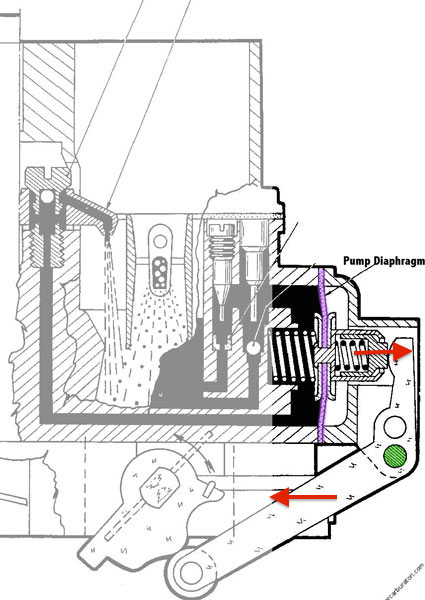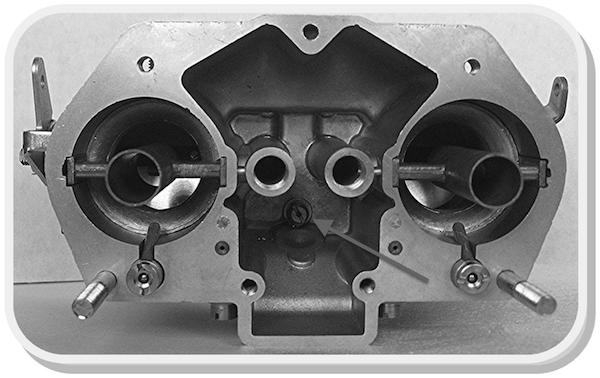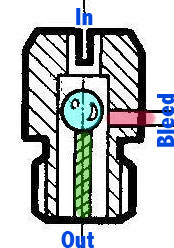|
|

|
Porsche, and the Porsche crest are registered trademarks of Dr. Ing. h.c. F. Porsche AG.
This site is not affiliated with Porsche in any way. Its only purpose is to provide an online forum for car enthusiasts. All other trademarks are property of their respective owners. |
|
|
| sgetsiv |
 Jul 6 2014, 08:26 PM Jul 6 2014, 08:26 PM
Post
#1
|
|
Former 914 Owner :(   Group: Members Posts: 159 Joined: 20-June 08 From: Portland, OR Member No.: 9,192 Region Association: Pacific Northwest |
I've been working on my carbs for the past few weeks to try and get them to run as close to perfect as possible. Here are the details at this point:
2315 Raby built engine EMPI HPMX Dual 44's 52 idle jets 150 main jets 200 air correction jets 55 accelerator pump jets New CB Performance Rotary Fuel Pump - 3.5 psi - stock location No fuel pressure regulator - just a TEE fitting Stack electrical fuel pressure gauge 0-15 psi - reads 3.1 psi when cold, 2.4 psi once everything warms up and is running Wide band AFR gauge Fuel lines flushed and fuel filters cleaned Gas tank pulled and re-installed lines at base to be sure there are no kinks I rebuilt the carbs with the EMPI rebuild kits which includes all new gaskets, accelerator pump diaphragm, new mini fuel filter, new float needle valve assembly, new washers for the accelerator pump jets, new o-rings for the idle jets and idle mixture screws. Floats are set to factory specifications as well. I pulled the throttle plates and was extremely careful to be sure I put them back exactly the same way and that they do not hang up - their action is perfect and they cover the progression holes. This project started a few weeks ago after running into lean issues under load - turned out to be the fuel pump relay was going bad. There was a significant voltage drop across the relay and it finally ended up failing completely during testing. Once the engine is fully warmed up, my AFR is reading 12 to 13 at idle; adjusting the idle mixture screws can make a big difference in AFR readings without changing the idle significantly. I started out with the accelerator pump jets set to factory setting of 7mm of thread exposed. During my test drives today, I turned them in (richer) to about 10mm. Response is better but still not perfect. I'm getting AFR readings in the 12-14 range during "regular driving" on the highway. Going up hill under load at 60-70 mph in 4th gear (say around 3500-3800 rpm) and very slowly pushing on the throttle creates a lean condition. Once I step on it, the AFR drops down to 11-12 and then settles again in the 12-14 range. I would really appreciate some input on adjusting the accelerator pump and any other suggestions on how to get the most of these carbs. Are the accelerator pump jets (55) big enough? They can certainly be reamed out. I did measure the output and got around 0.3 ml fairly consistently for each jet. All 4 jets spray straight right into the center of the carb in an even stream. |
  |
Replies
| McMark |
 Jul 7 2014, 09:32 AM Jul 7 2014, 09:32 AM
Post
#2
|
|
914 Freak!                Group: Retired Admin Posts: 20,180 Joined: 13-March 03 From: Grand Rapids, MI Member No.: 419 Region Association: None |
A little basic info, which I know Steve knows already. When you open the throttle a mechanical linkage presses on a diaphragm to pump fuel into the throttle body. Think of a turkey baster full of fuel - squeeze the bulb and it squirts. Lets go over the adjustments and jets. The pump system isn't as simple as most people think.
Adjustment Nut The tiny adjustment nut on the linkage adjusts the 'at rest' position of the linkage. The linkage arm you're adjusting pivots in the center (green dot) so when you move the nut out, the arm goes in. The picture below isn't an HPMX/IDF/DRLA, but shows my point. The lower arrow is where the nut would be. Moving the nut in (tightening) makes the upper portion of the arm move out. When that arm moves out the purple diaphragm moves out allow move fuel (black) to sit in the pump body. This adjustment changes the overall quantity of fuel potentially being squirted. But you must pay attention to the nut/arm being too tight or too loose. If you tighten the nut all the way, trying to get more fuel, you can actually make the arm move away from the diaphragm and introduce a gap. The diaphragm has a limited motion and can stop even if the arm keeps going. If you end up with a gap between the arm and the diaphragm, there will be a 'pause' when you open the throttle because the arm is moving, but hasn't contacted the diaphragm yet.  Accelerator Pump Jet This is the nozzle that squirts the fuel. It's the most obvious part of the system. A larger jet will allow a greater volume of fuel to spray out. This won't affect when the accel pump sprays, just how much. It's also worth noting that a small jet will squirt earlier and longer, whereas a HUGE jet will squirt later and shorter. Think of a hose that you turn on full blast for exactly 1 second then off again. A fully open hose will just burble out a little water. Now do that again with your finger on the end, and the water will actually squirt out across the yard, and it will squirt for a longer time. So a smaller jet can increase low throttle movement squirt characteristics. Check Valve and Bleedoff Port This piece is less widely known about. If you take the cover off your there is a small jet in the bottom of the float bowl. This is where the accelerator pump gets it's fuel supply. When you release the throttle, fuel is sucked through this port. There is a small ball inside that acts as a check valve (see pic). The purpose is so that when you open the throttle and pressurize the pump, it doesn't squirt all the fuel back into the bowl. This check ball valve must be operational. If you pull the piece out and shake it, you can hear the ball rattling inside a good one. If there is no rattle, it's not allowing fuel to pass and you need to get a replacement or clean it. If you flip the jet over there is a small plate (green in pic) that is pressed into place to retain the ball. On HPMX carbs this plate is too low. Because it takes fuel pressure in the pump to lift that ball and shut off flow back to the bowl, a ball that sits too low will take too long to close and will allow a lot of pump pressure to bleed off. On Steve's carbs (and any HPMX that comes through here) I pulled the jets out, tapped the retaining plate a bit deeper into the jet. This doesn't restrict fuel going into the pump, but makes the ball more responsive by reducing the amount of movement necessary to shut off the ball valve. Finally, there is a small bleed off port. You can get these check valves with a variety of sized bleed off ports. This port lets a small amount of pump pressure (fuel) to return to the bowl. This port mostly affects the amount of time the pump will squirt. If you reduce the size of the jet it will bleed off less fuel, therefore more fuel will come out the jet in the throat. The reverse as well, a larger jet will bleed off more pressure and reduce the amount that comes out at the throat.   |
Posts in this topic
 sgetsiv Carburetor Fine Tuning Jul 6 2014, 08:26 PM
sgetsiv Carburetor Fine Tuning Jul 6 2014, 08:26 PM
 Mikey914 Looks like classic thread to me Jul 7 2014, 09:33 AM
Mikey914 Looks like classic thread to me Jul 7 2014, 09:33 AM
 jmill
Looks like classic thread to me
:agree: Best ... Jul 7 2014, 10:35 AM
jmill
Looks like classic thread to me
:agree: Best ... Jul 7 2014, 10:35 AM
 sgetsiv I haven't tried a larger main jet yet but I ha... Jul 7 2014, 10:45 AM
sgetsiv I haven't tried a larger main jet yet but I ha... Jul 7 2014, 10:45 AM
 jmill
Note that the AC jets actually make the car run l... Jul 7 2014, 11:07 AM
jmill
Note that the AC jets actually make the car run l... Jul 7 2014, 11:07 AM
 Racer Chris Increasing the size of air correction jets will lo... Jul 7 2014, 11:15 AM
Racer Chris Increasing the size of air correction jets will lo... Jul 7 2014, 11:15 AM
 McMark Idle mixture screw on the side adjusts fuel flow w... Jul 7 2014, 11:34 AM
McMark Idle mixture screw on the side adjusts fuel flow w... Jul 7 2014, 11:34 AM
 rhodyguy i spoke with steve this am. asked all the trivial ... Jul 11 2014, 10:21 AM
rhodyguy i spoke with steve this am. asked all the trivial ... Jul 11 2014, 10:21 AM
 McMark The HPMXs can have misaligned throttle shafts/butt... Jul 11 2014, 11:23 AM
McMark The HPMXs can have misaligned throttle shafts/butt... Jul 11 2014, 11:23 AM
 matthepcat Great thread....bookmarked.
In all honesty the pr... Jul 11 2014, 11:39 AM
matthepcat Great thread....bookmarked.
In all honesty the pr... Jul 11 2014, 11:39 AM

 wndsrfr
Great thread....bookmarked.
In all honesty the p... Jul 23 2014, 08:03 AM
wndsrfr
Great thread....bookmarked.
In all honesty the p... Jul 23 2014, 08:03 AM
 rhodyguy mike blizzard learned all too well about the HPMX ... Jul 11 2014, 11:42 AM
rhodyguy mike blizzard learned all too well about the HPMX ... Jul 11 2014, 11:42 AM
 sgetsiv Just wait. I'll be posting some additional inf... Jul 11 2014, 11:48 AM
sgetsiv Just wait. I'll be posting some additional inf... Jul 11 2014, 11:48 AM
 jmill You could also try the F7 ET. The F11 provides a ... Jul 11 2014, 12:01 PM
jmill You could also try the F7 ET. The F11 provides a ... Jul 11 2014, 12:01 PM
 Racer Chris The lean transition can be cured with larger AC je... Jul 11 2014, 02:17 PM
Racer Chris The lean transition can be cured with larger AC je... Jul 11 2014, 02:17 PM
 sgetsiv Just a quick update...
Idle jets are now 57... Jul 16 2014, 11:59 PM
sgetsiv Just a quick update...
Idle jets are now 57... Jul 16 2014, 11:59 PM
 sgetsiv Installed 160 main jets and 220 air correction jet... Jul 23 2014, 12:59 AM
sgetsiv Installed 160 main jets and 220 air correction jet... Jul 23 2014, 12:59 AM
 jmill
I would like the mains to kick in sooner so I... Jul 23 2014, 08:29 AM
jmill
I would like the mains to kick in sooner so I... Jul 23 2014, 08:29 AM
 sgetsiv I've been driving Scarlett everyday for the la... Aug 8 2014, 12:22 AM
sgetsiv I've been driving Scarlett everyday for the la... Aug 8 2014, 12:22 AM
 rhodyguy excellent. :cheer: Aug 8 2014, 06:00 AM
rhodyguy excellent. :cheer: Aug 8 2014, 06:00 AM
 rgalla9146 Great thread
What AFR equipment are you using ... Aug 8 2014, 06:35 AM
rgalla9146 Great thread
What AFR equipment are you using ... Aug 8 2014, 06:35 AM
 sgetsiv I'm running the wideband AEM AFR - got it on E... Aug 8 2014, 11:40 PM
sgetsiv I'm running the wideband AEM AFR - got it on E... Aug 8 2014, 11:40 PM
 72hardtop You want to actually see how well you have the jet... Aug 10 2014, 01:49 PM
72hardtop You want to actually see how well you have the jet... Aug 10 2014, 01:49 PM

 sgetsiv
Once that's done go a larger size or two on t... Aug 10 2014, 04:34 PM
sgetsiv
Once that's done go a larger size or two on t... Aug 10 2014, 04:34 PM

 72hardtop
Once that's done go a larger size or two on ... Aug 10 2014, 10:04 PM
72hardtop
Once that's done go a larger size or two on ... Aug 10 2014, 10:04 PM
 sgetsiv On a hunch that the transition circuits were likel... Oct 18 2014, 06:47 PM
sgetsiv On a hunch that the transition circuits were likel... Oct 18 2014, 06:47 PM
 72hardtop
On a hunch that the transition circuits were like... Oct 19 2014, 07:35 AM
72hardtop
On a hunch that the transition circuits were like... Oct 19 2014, 07:35 AM  |
1 User(s) are reading this topic (1 Guests and 0 Anonymous Users)
0 Members:

|
Lo-Fi Version | Time is now: 9th July 2025 - 01:46 PM |
Invision Power Board
v9.1.4 © 2025 IPS, Inc.







